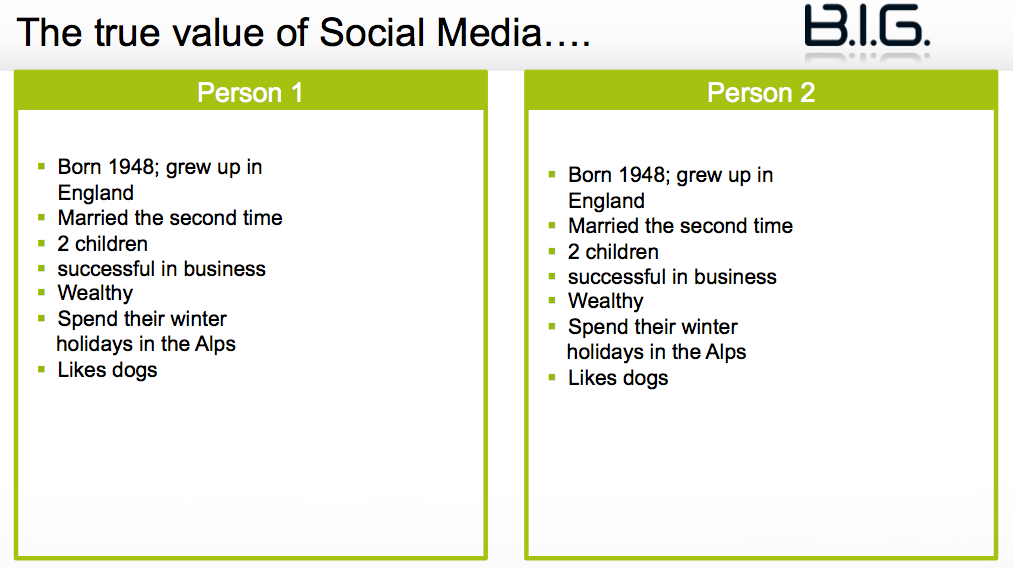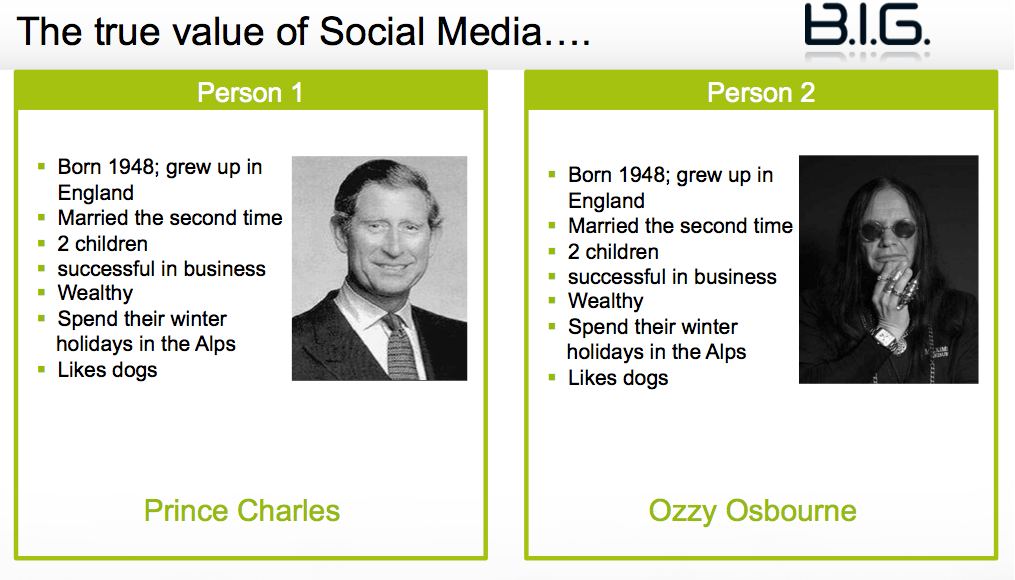Why Generation-C requires empathy and personalization not marketing…
In 2012, I spoke at a conference in Amsterdam focused on big data and intelligence to help businesses keep pace with the new generation of connected customers. I remember watching an informative and entertaining presentation by Dr. Peter Gentsch, founder of the Business Intelligence Group (B.I.G.) in Berlin. While this was two-years ago, a lifetime in today’s new media world, I feel his example is still as relevant today as it was then.
On stage, Dr. Gentsch shared an example that demonstrated the importance of understanding interests and behavior in marketing rather than that of traditional demographic profiling. Even though this point was a critical theme in each of my last three books, I’d not found a simple way to communicate the preposterous of generic persona modeling so succinctly as him.
Allow me to share…
The audience was presented with two seemingly similar profiles. Each individual was born in the same year as the other, in the same country. They were both married for the second time with two children. These individuals were successful, wealthy, vacationed in the Alps each winter, and they also shared an affinity for dogs.
Of course, the two individuals profiled simply by demographic data are not at all identical in how any thoughtful business would approach either successfully. Dr. Gentsh then demonstrates the almost comical nature of this comparison by revealing the identity of the two individuals. On one side we see Prince Charles. The other? Ozzy Osbourne. When viewed through this lens, the lush customer landscape we originally envisioned is suddenly not a marketing oasis after all. Traditional marketing as it turns out is becoming a mirage.
Keep calm and carry rock on.
Not that this insight is new or particularly revealing, but it is a sharp reminder that complacency is pervasive in traditional marketing. Regardless of new technologies, social, mobile, big data, et al., we are not unlocking new capabilities. We are in large part, still approaching innovation in customer engagement with a dated or classic mindset.
The days of demographic profiling aren’t completely behind us, but they are limited in overall reach and value.
Context is King! Behavior and Interests Reveal New Opportunities
Many marketers tend to view markets as audiences. Even in a social world, where many businesses are embracing new networks to reach customers, the social graph of these coveted networked relationships is essentially subjected to mass marketing or broadcasting under the illusion of two-way conversations.
As the Cluetrain Manifesto so rightfully proclaimed in 1999, “markets are conversations.”
“A powerful global conversation has begun. Through the Internet, people are discovering and inventing new ways to share relevant knowledge with blinding speed. As a direct result, markets are getting smarter—and getting smarter faster than most companies.”
Not only are markets now conversations, the audience is no longer passive or static. Their attention is no longer described in terms of eyeballs, traffic or time onsite. Audiences are now connected and democratized. The power of influence is shifting where it is not owned but instead shared. We are in fact faced with an informed and connected audience that now has an audience with audiences of its own. We are not just talking to people. We are presented with an opportunity to talk with and through them, activating networks, sparking conversations and engagement, and building relationships that offer mutual value.
This is no longer just about anonymously grouping traditional customers by audience demographics. That was then and it’s a time I’m relieved to see on the cusp of passing. Now, we must embrace connected customers based on digital, social and mobile. Connected customers, or as I refer to them, Generation C, aren’t grouped by age, education, or income. Instead, Gen-C reveals itself as the real people behind the faceless clicks exposing shared behavior and interests. This generation is uniquely visible by the context of the conversations they have, the people they know, the technology they use, the digital and real world places they frequent, and the brands, products, and other lifestyle objects that they socialize with.
It takes a shift in perspective and a new lens to see and appreciate them. If you don’t, they’ll simply evolve while you run in place.
See, Generation-C is by default connected. But it’s more than that. As a result of connectedness, Gen-C becomes empowered. Information is after all, a form of currency and access can contribute ultimately to status and power. As such, connected customers become more demanding. They expect to be heard. They expect personalization. They demand an integrated, frictionless and value-added touch at every stage of the journey, before, during, and after transactions. These discerning customers wish to be valued in both engagement and enchanted through experiences that are bigger and more important than your everyday product, sale, and service.

To identify them requires research and empathy. Generation C is not identifiable by demographics or generic personas. Generation C is a lifestyle…it’s everyone who lives a digital life. They’re connected and they’re in control. To evolve takes research that combines data science and digital anthropology.
To discover them starts with studying more than the networks and technologies they use. Marketers must now partner with research teams to learn about behavior within and around networks, apps and devices. Doing so uncovers interests, preferences, expectations, and destinations. As a result, you are able to see and map out the new customer journey. And, you learn how to do more than just react to actions, sentiment, and trends. You’ll realize how to create meaningful customer journeys that improve experiences in existing and also new touch points…throughout the entire customer lifecycle.
Meet your new customers…Generation-C. You may in fact already be part of this movement. As such, you are the very customer you’re trying to reach.
Connect with me:
Twitter | LinkedIn | Facebook | Google+ |Youtube | Instagram
Faceless image: ShutterStock








As we’ve discussed before this is our feelings, instincts and
perceptions work so much quicker than any computer when interacting,
responding and participating with people online.
We can use what we see, hear and learn in making the journeys you talk about for connected customers.
If
we continue to just record and sift data there’ll be things that those
in suits, ties and lab coats miss. Just like they missed The Beatles,
1968, Punk, 1980’s, House Music and Fashion.
There’s a reason these things are part of everyday culture today and it’s not becasue they were tested and researched first.
Love this comment…
Thanks Brian, in response to some natural and realistic thinking 🙂
I really enjoyed this post. It’s a new outlook on customers that I never thought of before and is very different than what most people do now. Generation-C is just the start of the new customer age and is very interesting to learn about. Grouping customers together that are involved and demanding of what they want in a company or product is a cool way to use demographics. Grouping them in this category will better a company or product because they can get direct feedback from the customers. I think all companies should try and find these Generation-C types of customers because they can only be benefit to the company or product. I like when you said that this type of customer is no longer static of passive, but they have an opinion and want to be heard.
Overall, great post!
Thanks for pushing us (again) to think about customers in human terms, not a as data point. I love how you turn this around on us: we think of ourselves as 3D humans, even on the web. Why not extend this same depth of field to our clients.
Cheers!
Cheers!
Thanks for sharing this. I totally agree that the old school method of slicing and dicing by demographics is fast becoming irrelevant. Unfortunately much of big business and governments still have to rely on that due to the lack of a robust alternative.
At this point, the greatest challenge is how we can balance between diving more deeply into consumer (or public) behaviours online while not scaring the wits off them amidst all the privacy and security concerns going on. Would a potential customer be happy to know that we have identified who their BFFs are, which restaurant they had their first date in, and their favourite sports team? 😉 I guess this may be something that require further research and insight.
Thanks once again for a great perspective on Generation C!
Great comment.
Great comment.
This is great, Brian. I like the term Generation C. In municipal government, community is still segmented by arbitrary age-range and general demographics. More of us need to see that a person over 60 can be just as connected as a person under 30, sometimes more so! Our resources must shift – because they’re not growing. While we can’t abandon previous methods of communication (newspaper, radio), we have to prioritize our resources toward the larger, more connected audience. Thank you for another insightful article.
Thank you Sarah!
Thank you Sarah!